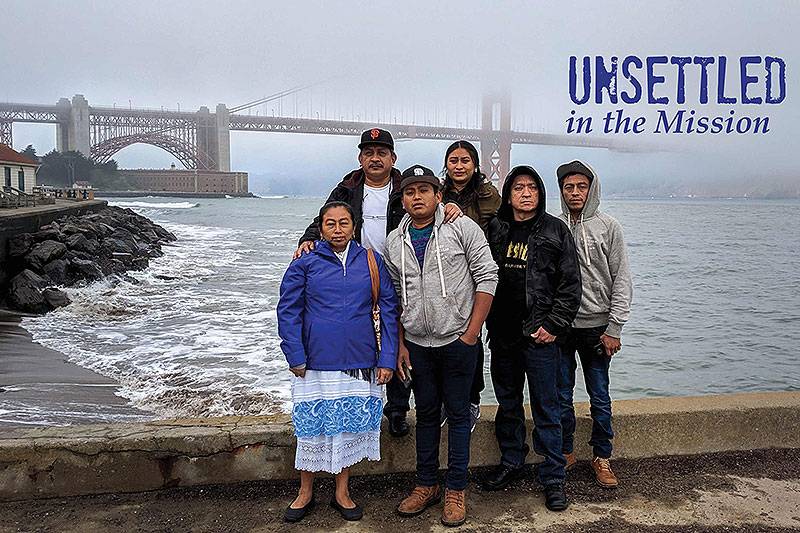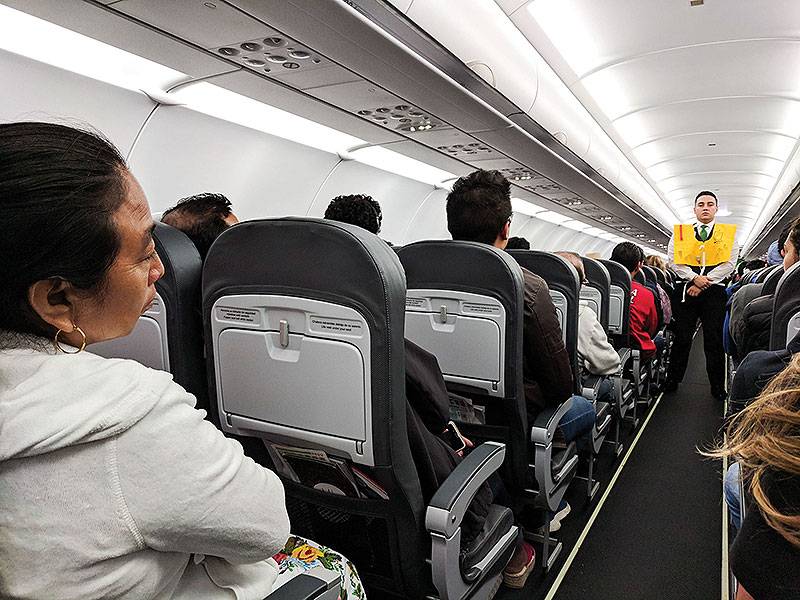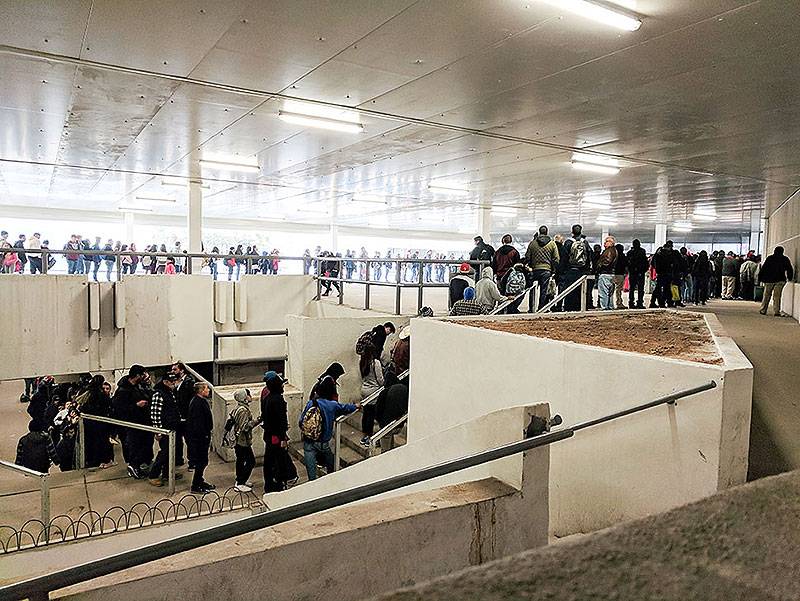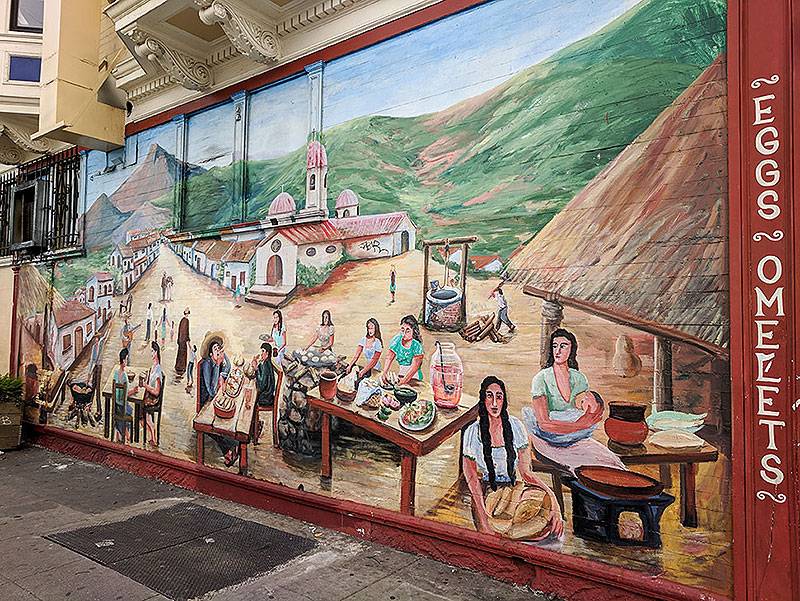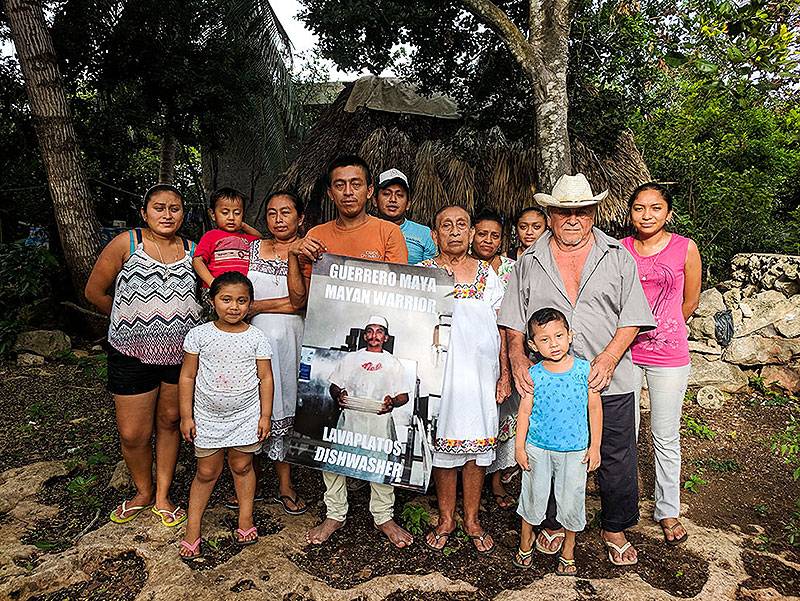Unsettled: Law & Border: Difference between revisions
No edit summary |
No edit summary |
||
| Line 124: | Line 124: | ||
[[category:Mission]] [[category:Indigenous]] [[category:2010s]] [[category:racism]] [[category:1776-1823]] [[category:1823-1846]] [[category:Mexican]] [[category:Latino]] [[category:Immigration]] | [[category:Mission]] [[category:Indigenous]] [[category:2010s]] [[category:racism]] [[category:1776-1823]] [[category:1823-1846]] [[category:Mexican]] [[category:Latino]] [[category:Immigration]] [[category:Spanish period]] | ||
Latest revision as of 20:18, 24 April 2021
Historical Essay
by Adriana Camarena
Originally published in El Tecolote January 31, 2019
(From left) Carmen May Can, Luis Poot Pat, Angel Góngora May, Rosana Góngora May, José Góngora Pat, y Luis Góngora May pose in front of the Golden Gate bridge on Jan. 10, 2019.
Photo: Adriana Camarena
I woke up on Jan. 2 in the winter warmth and humidity of Merida, Yucatan. Stiffened by the air travel of the previous day, I stretched and exercised because in less 24 hours I would start the trip back to San Francisco. We were in a race against time and distance to comply with a U.S. federal court order.
At 2:30 p.m. I arrived in an Uber at Merida’s Manuel Crescencio García Rejón International Airport, named for a representative of the radical federalist caucus who strongly opposed the signing of the Treaty of Guadalupe in 1848. By that treaty, Mexico would cede more than half of its territory to the United States of America after losing to the invaders, and draw the borderline that gives Trump so much to talk about.
At the airport entrance waited the family of the late Luis Demetrio Góngora Pat, who was killed by two SFPD officers on April 7, 2016 in the Mission District. A federal judge had issued an order requiring that Luis’ widow Doña Carmen May Can, and their children (Luis, Angel and Rosana Góngora May) as plaintiffs in a civil rights and wrongful death suit against his killers, prepare and deliver their depositions and attend a settlement conference in San Francisco from Jan. 3-11.
I picked out Doña Carmen from the group by the flowery pointillism of her embroidered hipil (a traditional garment worn by Indigenous women from Central Mexico to Central America). Standing by her, also in traditional Mayan dress, was Doña Estela Paat and Isabel Yeh Poot, mother and sister-in-law of the deceased respectively. Surrounding them were children and grandchildren dressed in modern fashion: jeans, t-shirts and hoodies.
Counselled by the Mexican Consulates in San Francisco and Calexico, the family’s legal team prepared the paperwork to request that Luis’s family be “paroled” into the U.S. to comply with the judge’s order. Such special requests are made at pedestrian cross points along the Mexico-U.S. border. I volunteered to accompany the family on their first cross country travel to the Special Permits Unit of the U.S. Customs and Border Protection (CBP) at Mexicali, which is why I found myself in Merida.
The four travelers I would be escorting to the border had packed lightly, knowing that expediency through gates, ramps, tunnels, metal detectors, bureaucrats and security guards would ensure that we be at the border early on Jan. 3, no sooner, no later. Simultaneously, on the Calexico side, attorneys Adante Pointer and Melissa Nold would arrive to backup the parole request and receive their clients.
I witnessed the gutsy courage with which the wife and children of Luis Góngora Pat abandoned the security of their homeland Yucatán for the very first time, to retrace Luis’s journey (if under very different circumstances). Luis Góngora Pat left their hometown of Teabo 18 years ago to secure their welfare. Now they followed his path to understand his fate and demand justice. After a six-hour delay, we flew out of Merida; finally we were northbound. Around midnight the plane tilted in its approach to México-Tenochtitlán, laying the lit Mexica megalopolis—“the Belly of the Moon”—at Doña Carmen’s feet, forcing her into a nervous if amazed smile. Our late arrival to Mexico City ensured barely two hours of sleep in a nearby hotel, when by dawn, we were back in the airport to catch our next leg to Mexicali. In Mexicali, we gasped at the frigid polluted air as we descended the plane stairs onto the tarmac, scrambling for the collection of sweatshirts and shawls that I had placed in my carry on. By 9:30 a.m. we were walking through the border tunnel to Calexico, escorted by a Mexican consular aid, skipping the endless pedestrian line, to surrender ourselves to the CBP.
Border Purgatory
The next four hours of our lives were spent in frontier limbo. Outside the Special Permits office, I sat in a black plastic seat linked by a metal bar underneath to identical other seats that went around the waiting area. I kept an eye on Luis’s family inside the office as they were “processed” through the slow chewing wheels of border bureaucracy that involved repeat rounds of questioning, fingerprinting, photographing and peering at screens. After three hours of waiting, just when a stirring from the office made me hope that the permit would be granted, the two officers stationed there took a lunch break. The lights to the office went out, abandoning us and the growing rows of special petitioners to a new level of border purgatory. On the Calexico side, the family’s attorneys stood desperate in their own border trap: shut out, imagining the worst—a failed and lonely trip back to San Francisco…
Doña Carmen May Can listens attentively to the flight attendant during her first-ever air travel, Merida, México, Jan. 2, 2019.
Photo: Adriana Camarena
The forced wait reoriented my attention to the continuous line of people who at an eyeshot from me succumbed to a daily ritual scrutiny from CBP officers at desk stations. The line of pedestrians began Mexico-side, beyond the tunnel entrance, and never let up once, never stopped, never gapped in its spiritual glide towards the United States. The line was an endless conveyor belt of foot arrivals and fortune holders of border crossing “laser visas,” resident green cards, tourist visas, American passports and pre-approved foreign passports. The consular aid explained that the pedestrian immigrants were, in their majority, day-journey agricultural workers at U.S. farms, Mexican students paying to attend U.S. public schools and thousands of domestic and other manual workers that fulfill a multitude of tasks on American soil on a daily basis.
In 2018, approximately 3 million pedestrians crossed the Calexico immigration bridges; over 4 million in 2017 (according to CBP data). Nearly 34 million pedestrians in total walked across the whole of the U.S.-Mexico border last year. If car, bus and train passengers are added, then the tens of millions of roundtrip border crossings multiply: 144 million land crossings in 2018 and 187 million in 2017. The sheer activity at the U.S.-Mexico border makes the 27 U.S. immigration checkpoints glorified turnstiles, ineffective funnels for the torrent of peoples pulsing back and forth on the border every single day. And if people cannot cross legally, they will cross illegally because migration is a part of our nature as human beings.
After a long and tight swaddling in American red tape, an equanimous CBP case officer returned with a permit in hand, making a point of branding fear in our hearts by reciting the dire consequences that would befall us if we weren’t back at that same border checkpoint before midnight on Jan. 11 when the spell of parole permit would be broken.
The Sweepings of the World
Having made it safely across, we exited onto a quiet, unpopulated, Calexico Street with our backs to the pinkish façade of the U.S. administrative building that comprised the American side of the border wall. I felt a slow drip of relief seep into my spine… and then came exhaustion. We began the two-hour drive from Calexico to San Diego. Doña Carmen, Luis, Angel and Rosana marveled at the farm and desert landscapes. An hour in, we swept past the boulder stacks at the edge of the Cuyamaca State Ranch Park on Highway 8. Rosana exclaimed in wide eyed amazement, “Where did all these rocks come from?” In 1775, as part of the De Anza expedition, Father Pedro Font would similarly marvel in his diary: “The canyon is formed […] by great mountains or rocks, boulders and smaller stones which look as if they had been brought and piled up there, like the sweepings of the world.” My Mayan friends would never be the same for travelling.
More than 24 hours later after our initial reunion in the Merida airport, and after one last plane ride out of San Diego, we finally reached San Francisco. At the airport, the quartet was met by the trio of their uncle José and their cousins Luis and Carlos Poot Pat. It had been 19 years since José had seen his family. Luis, Angel and Rosana were children, when he and then Luis exchanged their subsistence farming lifestyle in Teabo to forge a better life for their families working as janitors and dishwashers in the City by the Bay. Rosana wept while José held her: “This embrace that I give you,” she managed to say through the tears, “This is how I hoped one day to hug my father.”
People wait in line at the pedestrian immigration checkpoint in Mexicali, México on Jan. 3, 2019.
Photo: Adriana Camarena
For the past two years and nine months, the Góngora family had grieved and suffered Luis’s murder by police separated by the border; San Francisco was far flung from Teabo and the poor, by their very nature, lack the resources to travel, nevermind obtaining a visa to visit the United States. There was an indescribable mending at that moment of physical contact between the family members. I heard torn and dormant heart muscles awaken and regrow. I felt the brittleness of trauma ever so slightly smooth over. In the precious eight days that followed, the travelers with the help of José, Luis and Carlos would suss out the life of Luis Góngora Pat in San Francisco, exploring his places and his nonsensical and cruel death at the hands of officers Nate Steger and Michael Melone.
Cattle Conquest of California
In 1777, a year after the founding of the Mission Dolores, a group of Yelamu Ohlone men returned to the Lagoon of Sorrows (the name given to the former estuary beside which the original Mission Dolores was built) to observe and test the Spaniards who had taken over their village of Chutchui. In late December, they fired an arrow near a guard, threatened to shoot a neophyte (a converted) Indian, and a Yelamu man kissed the wife of a soldier. One Yelamu warrior was captured and flogged, while his two companions who had attempted his rescue were hunted down. The soldiers pursued them to Mission Bay where the natives mounted a retreating defense, shooting arrows at the Spaniards, wounding a horse and a man. A sergeant ordered the soldiers to fire, and a Yelamu man fell dead into the water. Shocked at their first encounter with lethal firearms, the Yelamu surrendered, throwing down their bows and arrows. This was the first killing of an original inhabitant by law enforcement on the San Francisco peninsula. The surviving rebels were flogged and threatened with death should they continue to resist.
I was invited by Shaping San Francisco to talk about the Mexican Californios who lived in San Francisco after the period of Spanish colonization (1776-1821), and more specifically, between the time Mexico claimed its independence from Spain in 1821 and 1846 when the United States of America occupied San Francisco during the Mexican-American War. Towards the end of the talk, an Anglo-American woman confused by the timeline of Spaniards and Mexicans in Alta California asked the following: “….there wasn’t really any Conquistadors in California […] Were they [the indigenous people…] enslaved? Did that resemble what the Conquistadors had set up to get all that labor for free?”
The audience member seemed confused by how the Ohlone Bay Area peoples were subjugated through the Mission system, if not by metal helmeted, sword wielding, horse riding genocidal conquistadors. “Conquistadors” is the name given to the conquering armies of the Spanish and Portuguese empires in the 16th century. México-Tenochtitlán was conquered in 1519. From there, a northbound Spanish exploration reached the tip of a peninsula in 1533, which the explorers took for an island. They named it California, presumably after the island of that name that appears in the 1510 romance novel “The Adventures of Esplandián” by Garci Rodríguez de Montalvo, which was said to be inhabited by Black Amazon-like women who rode wild beasts bridled in gold. Further sporadic exploration would disprove the island geography, but secure the claim of the Spanish Crown upon the coastal lands that encompassed the Baja (Lower) and Alta (Upper) Californias. Alta California, however, would not be settled until the late 18th century, when the growing incursion of foreigners—Russian fur trappers slipping down from Alaska, and the British expanding in Canada—presented a credible threat to the Crown’s hold over the northern lands. The deployment of colonizers happened swiftly.
In 1768, the ports, presidios and missions of San Diego and Monterey were established. One year later, the explorer Gaspar de Portolá y Rovira in attempting to find a land route to Monterey overshot the bay, and instead spied the massive San Francisco Bay from a hilltop. In 1772 the Viceroy of New Spain assigned the Territory of Alta California as a missionary project of the friars of the Order of San Francisco de Assisi. Soon after, in 1774, the Spanish explorer Juan Bautista De Anza set out by foot and by horse, accompanied by leather-jacket soldiers, missionaries and a few settlers to expand the coastal presidios and missions in Alta California in a string of 21 settlements from San Diego to Solano. The Presidio of San Francisco and Mission Dolores were established in 1776. On a timeline of world events, that same year, the United States of America claimed its independence from Great Britain, heralding the start of the wars of independence from colonial powers in the Americas.
A mural at 17th and South Van Ness streets in the Mission District that depicts a ranch scene, Dec. 19, 2018.
Photo: Adriana Camarena
Perhaps the 18th century missionary system may mistakenly appear to be a light-handed conquest by comparison to tales of historic battles that decimated Tenochtitlán; once the sophisticated power center of the Aztec empire that in 1519 had a population comparable to any of the largest European cities at the time. But beyond the conquest, it was the systems of control and cultural reconfiguration imposed by the Spaniards that would do the greatest harm in the Americas. By the time the missionaries reached the Bay Area, Spain had supplanted bloody conquest with more than 250 years of experience in mass subordination and enslavement of Indigenous peoples to colonial industries, in the name of Catholicism, backed by soldiers’ muskets.
With the passing of time, as the missions increased their productivity, new Ohlone recruits would be forcefully rounded up by Spanish soldiers, further fracturing local communities. Over the next decades, Indigenous populations were reduced through waves of epidemics of Eurasian diseases such as syphilis, measles and smallpox that particularly impacted mission-bound neophytes. Cows, however, were the biological weapon that delivered the fatal blow, forever altering the native ecologies upon which the first peoples’ way of life depended. Spanish missionaries and settlers also introduced crops that were staple produce for their international trade. Historians Hunt Janin and Ursula Carlson write: “By 1800 the herds of cattle in Alta California totaled 187,000 animals, of which 153,000 were in the pastures of the missions. By 1805, there were also more than 130,000 sheep, most of them owned by the missions. The total crop production of 19 missions was almost 60,000 fanegas (bushels), that is, about 720,000 Imperial bushels, or 3,300,000 liters, of wheat, corn, barley, and beans.” (Source: “The Californios: A history, 1769-1890”)
The damage done to the Ohlone way of life in only 45 years of Spanish occupation of San Francisco is staggering. Before the Spanish arrived, the Ohlone lived in an abundance of protein sources, including acorn mush and a variety of animals from mollusks to whales, salmon to otter, rabbits to elk, deer to bears, quails to ducks. A rich variety of languages were spoken from tribe to tribe, and a system of alliances through marriage ensured safety and permanent occupation of ancestral lands. Their skills at weaving tule reed were unparalleled for quality in hut, basketry, boats and dress. After their communities, culture and natural environment were upended by the Spaniards, the Ohlones’ capacity to live outside the Mission system narrowed with each passing year.
Turnover of Land in Alta California
The lifestyle of the Mexican Californios in the 25 year period that followed the Spanish occupation of Alta California is often romanticized as an idyllic Mexican pastoral paradise of ranching families socializing in fandangos, and vaqueros famous for their lassoing skills. In truth, it was mostly a continuation of the Spanish cattle economy and culture, now in the hands of Californio aristocratic land barons. In 1823, the Russian Captain-Lieutenant Andrey Lazarev, while wintering in San Francisco aboard the sloop Ladoga (and with palpable disdain for the local Californios) wrote “Nothing can be said about aquatic fauna because the abundance of cattle, which afford their best food, diverts the lazy from fishing.” He described the road to the Mission Dolores as, “easily recognizable from the heads of bulls and the bones and carcasses of dead horses scattered everywhere; the foul smell from them and the flocks of crows, seagulls, and various hawks devouring all of this carrion usually means the proximity of habitation. I think that this province is indebted solely to the feathered kingdom for protection against infectious and epidemic diseases.”
From 1824 to 1828, Mexico as a newly minted federal republic, issued colonial laws and rules for providing land grants in California. The Governor of Alta California had the power to grant state lands, which resulted in a nepotistic distribution that asserted the standing of a wealthy cadre of elite hacendados. These land owning Californios continued the exploitation of lower social castes of mixed-race (mestizos) and native populations as indentured servants or flat out slaves on their ranches. In 1833, as a means to further cut off ties between Spanish loyalists, the Mexican government secularized the Missions, repossessing approximately 1,000,000 acres (400,000 ha) per each of the 21 California missions. The secularization decree ordered the distribution of mission lands (no more than 28 and no less than 7 acres) to each Indian head of household that at the time lived at a mission, plus a portion of livestock, chattels, tools and seed. Most of these lands went unclaimed as the neophytes fled for freedom or were forced out by other more powerful parties. The Mission Dolores lands were distributed piecemeal to various grantees, among them: Jose Manuel Valencia, José Cornelio Bernal, Francisco De Haro and José de Jesús Noe; the latter two were twice governors of the Pueblo of San Francisco in different periods.
While life in Alta California carried on as usual, the central Mexican government battled to keep control of its national territory. Almost as soon as Mexico declared its independence in 1821, it shed lands, starting with the Kingdom of Guatemala and territory south of there. Factional conflict from 1835 and 1840 between liberals seeking a representative federal democracy and conservatives wanting centralized government control further resulted in the declaration of independence by Texas, the Republic of Rio Grande (Coahuila, Nuevo León, Tamaulipas, parts of Texas) and the Yucatan. In 1838 Mexico fought off the French in Veracruz, while fending off Comanche raids and the Yaqui wars of independence in the north; the latter by kidnapping rebels and sending them off to henequen haciendas in Yucatan.
A decade earlier the U.S. government had begun enforcing its “Manifest Destiny” doctrine, marching west with the intent to bring more land into its fold. In 1846 the Mexican government, despite being spread thin, was forced to fight the invading American troops that had crossed from Texas into Mexican territory. As soon as news of the Mexican-American War spread, American soldiers occupied Sonoma and the port of Yerba Buena (later to be renamed San Francisco). In 1848 Mexico capitulated to the terms of the Treaty of Guadalupe Hidalgo, narrowly avoiding further loss of territory. That year Yucatan was forced back into Mexico, only to be caught up immediately in the Caste Wars (1847–1901) with the revolt of native Maya people against the European-descended population.
The Treaty of Guadalupe stated that the property rights of Mexican subjects would be kept inviolate; a term that in practical terms was voided, when the United States enacted the 1851 Act to Ascertain and Settle Private Land Claims in the State of California. The new act placed the burden of proof of property on the holders of Spanish and Mexican land grants by requiring them to present their titles for confirmation before the Board of California Land Commissioners. Huge swath of lands were lost by Californios through extended litigation and every kind of settler chicanery including murder. Infamously the 19-year-old twin sons of Francisco De Haro and Emiliana de los Reyes—Francisco and Ramon—were allegedly murdered by Kit Carson on the orders of U.S. Army Major John C. Fremont at the start of the Bear Flag Revolt. The sons of de Haro were 1844 grantees of Rancho Potrero de San Francisco on Potrero Hill. Their grieving father opted to sell the land rather battle opportunistic settlers.
Genocidal use of force in California
Unlike the Spaniards and Mexicans who depended on indentured or free labor of Indigenous or mestizo populations, the American settlers saw the surviving Native American populations as an inconvenience to their expansionist goals. The wholesale rape, killing, kidnapping, and massacre of California Indians plunged their already decimated numbers from an approximate 150,000 in 1848 to 30,000 in 1870. The wealth and sophistication of the cosmology, languages and skills of the Bay Area tribes was nearly obliterated in the land grab.
The family of the Luis Góngora Pat, the migrant man slain by SFPD in 2016, poses in their common homestead patio on June 30, 2018.
Photo: Adriana Camarena
California’s “use of force” laws that allow officers to use “reasonable” force to make an arrest or overcome resistance were established shortly thereafter in 1782. They remain unchanged despite efforts to pass a modifying bill in Sacramento last year. Vocal and active social justice movements clamoring for greater police accountability are ignored. In fact, the conservative U.S. Supreme Court has instead handed down a series of cases that will ensure that officers remain immune from liability for constitutional violations—such as the unwarranted taking of a life—for the foreseeable future. People of color and the poor have been shown repeatedly by the justice system that neither police nor the law serves them. But Indigenous and other discriminated peoples, like Luis’s family, continue to survive and carry forth their cultures through age old strategies and tactics of resistance.
On Jan. 10, attorney Melissa Nold and I accompanied Doña Carmen, Luis, Angel and Rosana back to the San Diego, to ensure a timely crossing to Mexicali early in the morning of Jan. 11. Their uncle Wilberto drove us in his van to SFO so we could catch the first leg of our trip. On our way, we made a last and brief stop at the site of Luis’s killing. He was nicknamed “El Sapo” (toad) by his family. All week I had been carrying a wood carved jewelry box in the shape of a toad to their legal proceedings. I took it out again at the altar, and opened the fat mouth of the toad, calling out to Luis Demetrio Góngora Pat, “¡Vámonos, Sapo! Es hora de irnos a casa.” (“Come on Sapo! It’s time to go home!”) and as soon as I felt him jump into the car, I clapped down on the lid and handed the box to Doña Carmen. In Mexicali, I gave each one a hug goodbye. This time I wouldn’t escort the family all the way back to Merida, because they already knew how to fly.
About Unsettled
Unsettled in the Mission is a series of literary non-fiction essays by Adriana Camarena to be published periodically as supplements in El Tecolote through January 2019. Her writing is based on portraits of the traditional working class and poor residents of the Mission District for an exploration of Latino identities and histories. This is a collaborative project supported by the Creative Work Fund, however, the views and opinions expressed in “Unsettled” are those of the author and do not necessarily reflect those of Acción Latina.
About the Author
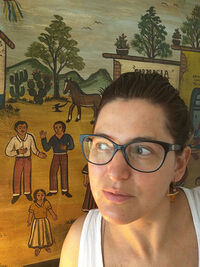
Adriana Camarena is a Mexican from Mexico, complicated by an upbringing in the U.S., Uruguay, and Mexico. She became a resident of the Mission District of San Francisco in 2008. Since arriving in the Mission, Adriana began collecting tales of borders, line-crossings, and overlapping identities told by residents to provide a layered picture of this traditionally working class immigrant neighborhood in California. To learn more about the author and her work, please visit her website.

